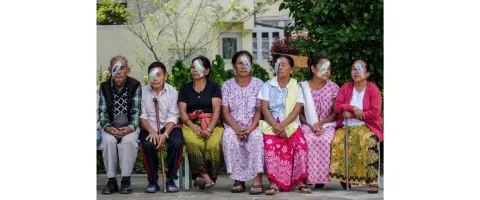NCDA supporter & full member
About The Fred Hollows Foundation
The Fred Hollows Foundation is a leading international development organisation working towards a world in which no person is needlessly blind or vision impaired. Established in Australia in 1992, the Foundation now works in more than 25 countries and has restored sight to more than 2.5 million people worldwide.
The Fred Hollows Foundation’s priority is to work with communities to improve their own eye health. They do this through life-changing surgeries and treatments, training doctors and health workers, generating new ideas and pushing for change at all levels, from global to local. The Foundation’s priorities include ensuring effective cataract treatment is accessible to all and finding and adapting affordable, effective solutions for diabetic retinopathy and other eye conditions.
Eye Health and NCDs
Vision plays a critical role in every aspect of our lives. Vision is often taken for granted, but without it, people can find it difficult to move about safely, read and write, participate in school and work. Vision impairment occurs when an eye health condition affects the visual system and one or more of its vision functions, and has serious consequences for the individual across their lifecourse.
Many eye health conditions are NCDs, for example:
-
Refractive Error (myopia - a problem with the focusing of light on the retina due to a mismatch between the optical components of the eye and the length of the eyeball – or presbyopia, the inability of the eye to focus light onto the retina due to ageing);
-
Cataract (clouding of the lens leads to increasingly blurred vision and can affect one or both eyes); Glaucoma (progressive damage to the optic nerve, often associated with raised pressure in the eye);
-
Age Related Macular Degeneration (damage to the central part of the retina responsible for blurred, distorted or no vision in the centre of the visual field); and,
-
Diabetic Retinopathy (a complication of diabetes which is the leading cause of blindness and vision impairment among working-aged adults, despite being treatable through early detection and treatment).
The most common noncommunicable eye health conditions often manifest in individuals with other NCDs. Recent studies have shown that people with vision loss or eye health conditions are more likely to have other NCDs than people with good vision. For example, a series of population-based studies in high-income countries revealed that 14% of people with vision loss had chronic obstructive pulmonary disease (COPD), 27% had cancer, and 39% had heart disease. However, the relationship between eye health conditions and other NCDs is complex and more research is needed.
Address
61 Dunning Ave
Rosebury 2018
New South Wales
Australia
Website
Twitter
Facebook
LinkedIn

